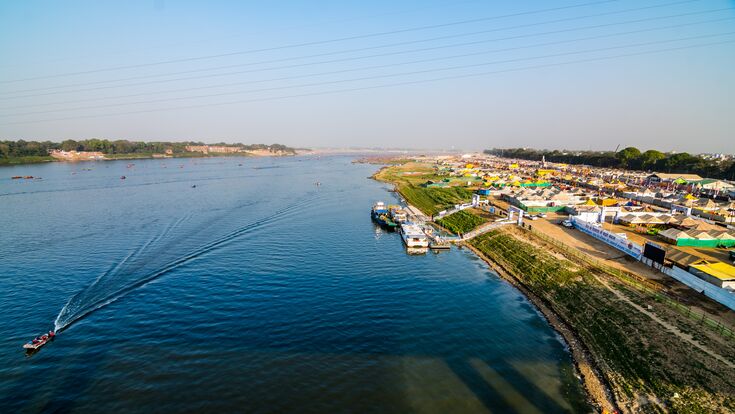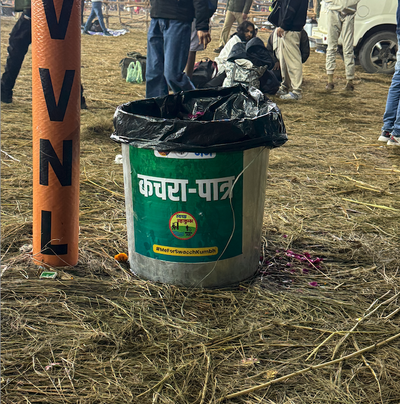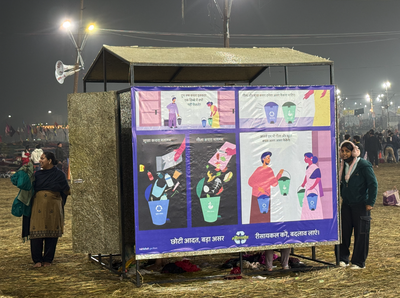Sustainable Waste Management : Maha Kumbh 2025: A remarkable feat of organization and devotion

Maha Kumbh 2025 in Prayagraj, India, is one of the largest gatherings of people in modern history. Organizing an event of this scale—expected to host around 500 million people over 45 days—is an extraordinary challenge, yet the level of planning and execution is truly impressive. From a logistical standpoint, the management of such a massive crowd is a testament to careful preparation and coordination.
The moment one arrives in Prayagraj, the spiritual significance of the event is unmistakable. Every aspect of the environment reflects a deep sense of devotion, yet what stands out just as much is the efficiency with which the event is run. Cleanliness, security, and crowd management are handled with remarkable precision, ensuring that millions of pilgrims can participate in the experience smoothly and safely.
For those who have ever wondered what large-scale event management looks like at its best, Maha Kumbh offers a compelling example. It challenges outdated perceptions of India as a place of disorganization by demonstrating how well a complex event of this magnitude can be handled. It is particularly striking to see that even after days when millions of people gather at the riverbanks for ritual baths, the area is meticulously cleaned and restored by the next morning. Witnessing this firsthand on January 15, the day after the Amrit Snan, was a moment of real appreciation for the scale and efficiency of the operation.
For professionals and students of logistics and waste management, Maha Kumbh provides an unparalleled case study. Every aspect, from sanitation to crowd flow, is carefully designed to work in unison. The coordination between various agencies, along with the integration of both human effort and technology, ensures that the event runs smoothly.
Maha Kumbh 2025 is not just a religious gathering—it is an incredible demonstration of planning, teamwork, and dedication on an unprecedented scale.
Establishing regular waste collection
Work has been done at various levels to keep the temporary new city of Maha Kumbh clean and beautiful so that, firstly, there is no dirt of any kind, and if it does happen, it can be cleaned quickly. In the entire area, dustbins equipped with black and green bags have been installed in large quantities for dry and wet garbage, and a sufficient number of men and women with long brooms are working 24 hours a day to clean the dirt created on the ground by undisciplined persons. All these workers carry black garbage collecting bags along with their brooms so that the garbage can be collected immediately. Otherwise, even the sweeping will be of no use and the garbage will be flown away by the air currents. These workers are in abundance at the ghats (riverbanks) and especially at the bathing places and can be identified anywhere as people wearing green jackets.
In my personal experience, I have found them constantly engaged with dedication and honesty towards their work. It is the result of this that garbage does not remain on the ground even for a moment. Swachhata Mitras (Waste Collectors) collect and deposit garbage in black bags within short distances in the entire fair area and as soon as the transportable load is complete, it is transported to the designated transfer station through a small vehicle, where compactors are stationed and this vehicle directly unloads the black bags into those compactors, which finally reach for processing or disposal. Such arrangements have been made for communication between the black bags and the vehicle so that the black bags do not remain there for a long time and do not get damaged in any way and spread here and there. The entire system is being carried out by Swachhata Mitras in three shifts and under strict supervision and monitoring, their transportation to the designated place is being ensured without any error.
>>> Rags to Riches? The Urban Waste Management in India Saga

To make the garbage management system effective and efficient, separate arrangements have been made for the entry and exit of such essential services-related vehicles so that the circulation can be uninterrupted. Another good step taken in this scheme is to divide the entire system among multiple agencies and get the work done. So that there is no dependence on a single agency and the entire scheme does not have to suffer the consequences of its failure. With the involvement of multiple agencies, various types of alternative resources remain available. Due to these options, there is also a sense of competitiveness amongst implementing agencies and quality is ensured.

Banning single-use materials
In such events, the maximum amount of garbage is generated due to single-use disposable materials. Along with this, the use of plastic in large quantities in various ways also leaves an ugly stain on the entire system. To get rid of all this, in this Maha Kumbh, on the initiative of Rashtriya Swayamsevak Sangh, through the One Plate-One Bag campaign, every pilgrim has been provided with steel plates and cloth bags instead of disposable ones, encouraging them to use them throughout their stay and afterward. It enables them not to look for plastic bags and to keep any material in the bag repeatedly, also to use plates for food and snacks etc. In the same sequence, arrangements have been made for clean drinking water at every step to avoid the use of bottled water. Plates and steel glasses have also been made available for use in places of gathering like Ashrams, Akhadas, Satsangs, Accommodation, etc. established in the entire fair site, and it has been ensured that disposable material is not used there at all.
Another important initiative that has been taken in this year's Kumbh is to get rid of disposable material, that is, a ban on the open distribution of any kind of food and beverage material etc. This rule has been implemented that distribution of any kind of food or beverage material etc. should be done only at a planned and covered place, where there will also be proper arrangements for collecting segregated garbage. In this regard, permission from the District Magistrate or Fair Authority has been made mandatory. Generally, as a result of the distribution of food, beverages, etc. here and there in religious events, padayatras (religious processions) etc., disposable material remains spread everywhere for many days after the event and it becomes a cause of pollution along with uncleanliness. According to the information, the ban on the distribution of food and drinks in the open is not only restricted to the fair area but has also been implemented in the entire Prayagraj region. This initiative is an exemplary step for India and the world, it also ensures the hygiene of food and drinks.
Using recycled materials
One of the important innovations done in this Maha Kumbh event is the establishment of a large number of changing rooms for men and women at the river ghats, bathing ghats and Sangam banks. All these changing rooms have been made using recycled plastic sheets and it has also been displayed very clearly. Along with this, the basic rules of waste management such as Reduce, Reuse, and Recycle have also been defined in very simple language on walls of these rooms, along with graphic and pictorial representations of the entire process, so that the common people can read and see and adopt it. Certainly, this effort will have far-reaching results. Another notable fact is that messages have been written on innumerable dustbins using both Hindi and English languages so that they can be read without being language barrier.
This experience, along with the remarkable organizational efforts behind it, will likely be studied for years to come as a model of large-scale event management. The lessons learned here could serve as a foundation for future planning, particularly in the field of waste management on a global scale.

The success of Maha Kumbh 2025 is not solely the result of government initiatives. It is a collective effort, where every stakeholder—organizers, authorities, volunteers, and the community—has played an active role with dedication and coordination. Their combined efforts have contributed to the smooth execution of this massive gathering, setting a new benchmark for events of this magnitude.
About the Maha Kumbh
The Maha Kumbh Mela in India, a Hindu pilgrimage festival, is the world's largest peaceful congregation of people. It is scheduled from 13 January to 26 February 2025 at the Triveni Sangam in Prayagraj, Uttar Pradesh. For the event, the Government of Uttar Pradesh has set up a temporary city covering 4,000 hectares to accommodate the estimated 400 to 450 million pilgrims attending the event. The devotees come together to immerse themselves in the Ganges, Yamuna, and Saraswati, waters of which are considered holy by the Hindus.
The views and opinions expressed in this article are those of the author and do not necessarily reflect the official policy or position of WMW.

